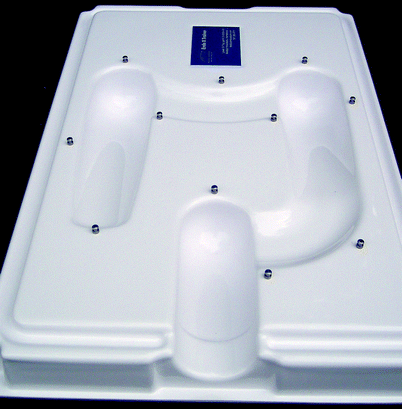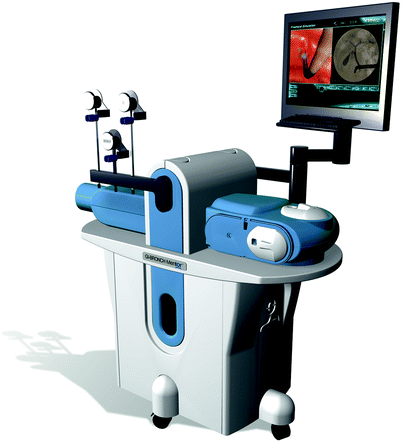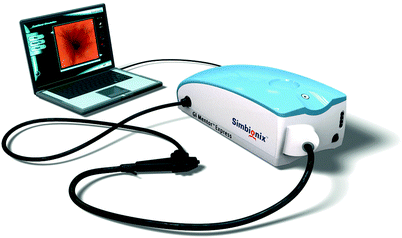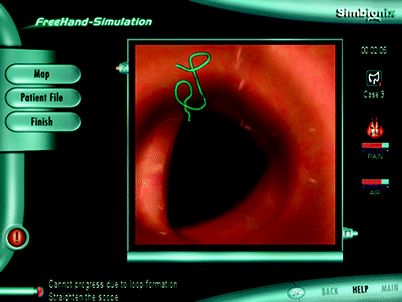Fig. 24.1
Simulation teaching of thermal hemostasis using combined technology with harvested (ex vivo) porcine organs
Gastroenterological Animal Models
To a certain extent, animal models remain the most realistic endoscopy simulators. Live animals, in specific, can provide a tactile and haptic experience that is remarkably similar to working with humans. Many live animal models favor juvenile pigs (approximately 35 kg in weight) and involve general anesthesia (Fig. 24.2). The use of such models on a wide basis is limited, appropriately, by the expense, facility requirements, and ethical considerations involved in their use.


Fig. 24.2
Simulation training on an anesthetized pig serves as an effective model for teaching and acquiring skills
Explanted animal models can also be used to simulate a number of important endoscopic interventions in a controlled setting, including polypectomy, endoscopic mucosal resection (EMR), endoscopic retrograde cholangiopancreatography (ERCP), and double-balloon enteroscopy. Generally speaking, the explanted organs must be situated in a mechanical device in a composite fashion (Fig. 24.3). The most commonly used composite simulator is the Erlangen Active Simulator for Interventional Endoscopy (EASIE) (ECE-Training, GmbH, Erlangen, Germany), which was developed specifically to provide training in therapeutic techniques, such as hemostasis. Modified, lighter-weight tabletop versions including the Erlangen compactEASIE, and the Endo X Trainer (Medical Innovations International, Rochester, MN) are designed to incorporate porcine organs (Fig. 24.4). Disadvantages of these models include complex preparatory routines, acquiring and disposing of explanted tissue and often unrealistic look, feel, and behavior of cadaveric tissues, which can detract from the experience.



Fig. 24.3
Explanted porcine organs arranged for use in endoscopic simulation of small bowel double-balloon enteroscopy

Fig. 24.4
Top and side view of the Endo X Trainer, a porcine endoscopy mold. The explanted porcine organs go in the mold for use in simulation (Image from http://www.medicalinnovations.com/text/endoscopic%20training%20device%20endo%20x%20trainer.html. Used with permission from Medical Innovations)
Computer-Based Endoscopic Simulators
Computer-based simulators for gastrointestinal procedures involve the insertion of a mock scope into an anatomically illustrative orifice to initiate a re-creation of visual and tactile sensations involved in using a flexible endoscope to examine and treat either the upper and lower gastrointestinal tract. Of two categories of computer-based simulators, virtual reality simulators and physical models, the virtual reality simulators are generally stand-alone systems that are specially equipped with dedicated monitors and endoscopes, while the physical model simulators (i.e., the Koken Colonoscopy Training Model Type 1-B (Koken C. Ltd., Tokyo, Japan)) are used in conjunction with real endoscopic equipment. One study by Hill et al. compared virtual reality endoscopic simulators with physical models and found little difference across simulators in terms of their overall realism, while only the virtual reality simulators provided more realistic auditory feedback regarding simulated patient discomfort [40].
There are currently two different virtual reality models of computer-based part-task endoscopic simulators that are commercially available: the GI Mentor (Simbionix USA, Cleveland, OH) and CAE Endoscopy VR simulator (CAE Healthcare, Montreal, Quebec, Canada). Both models provide diagnostic and therapeutic endoluminal experiences, record performance metrics of operators, and have been independently shown to have construct, content, and face validity [39, 41], as well as reliability [39, 42].
The GI Mentor simulator consists of a mannequin though which a modified endoscope (Pentax ECS-3840 F) can be inserted through one of two orifices that are representative of either a mouth or an anus [43]. The modified scope has an extremely high degree of realism and includes an air/water button, a suction button, and a working port that enables the simulation of diagnostic and therapeutic maneuvers, including biopsy examination, polypectomy, balloon dilation, and electrocautery. As with actual procedures, the examination is projected on a monitor located behind the patient (Fig. 24.5).


Fig. 24.5
Simbionix’s GI Mentor is a virtual reality model for computer-based part-task endoscopic simulation. A modified endoscope can be inserted through one of the mannequin’s two orifices while projecting the examination onto a monitor (Image used with permission from Simbionix)
Rather than a mannequin and standard scope, the CAE Endoscopy VR system is a simulator platform that consists of a cart, CPU, monitor, and a specially made proxy scope [44]. As a scope insertion point, the CAE Endoscopy VR uses an “interface device” with an appropriate anatomical reference plate. The GI Mentor has recently been adapted in the GI MentorTM Express, which includes all of the software, but is designed to be more elegant and portable (Fig. 24.6). As with the GI MentorTM Express and the original GI MentorTM, insertion of the scope into the anatomical opening of the CAE Endoscopy VR initiates a computer program that allows a tactile, audio, and visual experience similar to live endoscopy.


Fig. 24.6
The GI Mentor Express is a portable adapted version of the GI Mentor. A modified scope is inserted into orifices representative of mouth or anus to simulate live endoscopy (Image used with permission of Simbionix)
In both models, insertion of the endoscope triggers a software program, which brings up sequential computer-generated images on the monitor of either the upper gastrointestinal tract or the rectum and colon, as appropriate to the insertion point. Sensors along the scope and within the torso of the mannequin track the motions of the endoscope resulting in computer-generated feedback in the form of tissue resistance, as well as insufflation of the intestine secondary to manipulation by the operator. Haptic feedback also reproduces the sensation of scope looping and resistance, and audio feedback occurs in the form of a computer-generated voice that simulates patient discomfort.
In addition to procedural simulation, the GI Mentor includes “game modules” for manual dexterity training that allow more novice endoscopists to develop skills controlling the endoscope dials and using torque. The simulator also incorporates a series of cases of varying pathology and technical difficulty. Instructors may delineate specific training programs, and trainees can receive immediate feedback during and after completing each simulated procedure. The computer generates auditory and visual expressions of pain, including moaning and distressed facial expressions, for overinsufflation, looping, and excessive force on the mucosal wall (Fig. 24.7). Performance is recorded, including number and types of errors made. The instructor can provide feedback to each trainee based upon a “videotape” of the simulated procedure and written procedure reports generated by the trainee that help to determine whether abnormalities were correctly detected.


Fig. 24.7
The GI Mentor is capable of delivering immediate feedback to trainees and instructors during the simulated procedure. This figure shows the scenario in which the scope is unable to proceed due to loop formation (Image used with permission of Simbionix)
Both systems record performance metrics while a simulated procedure is being performed. For the GI Mentor II, these consist of the following: adverse events (e.g., scope-to-bowel trauma, bleeding, and perforation), time required for the procedure, percentage of mucosa visualized, whether retroflexion was performed or not when appropriate (e.g., to visualize the cardia of the stomach or the distal rectum), the number of inappropriate (dangerous) retroflexions, the time spent with obscured visualization of the mucosa (i.e., because of touching the tip of the scope against the intestinal wall, not using water to clear the lens), and patient pain.
Validity of Part-Task Computer-Based Endoscopic Simulators
Several studies have determined the general validity of both models of gastrointestinal procedural simulators, defined as the extent to which measures are true to what they are designed to measure. There are several forms of validity that are relevant to gastrointestinal simulators. Several studies have examined face validity, defined as the degree to which the experience they evoke for the user is comparable to real procedures on actual patients [15, 45, 46]. Secondly, simulator content validity has been established in the sense that simulator activities adequately reflect subject matter encountered during live endoscopic procedures [1, 10, 15].
A number of other studies have examined the construct validity of gastrointestinal simulators, defined as the extent to which assessment by the simulator can discriminate between different ability or experience levels of endoscopists [10, 11, 39, 41, 47]. For example, Moorthy et al. divided physician participants into three groups according to prior experience (novices with none, intermediates with 10–50 prior, and experts endoscopists with >200 prior) and found that the more experienced endoscopists took less time to perform a complete upper gastrointestinal procedure on the GI Mentor, visualized more mucosa, and performed less inappropriate and dangerous maneuvers [39]. Similarly, Felsher et al. demonstrated the ability of the GI Mentor to discriminate between colonoscopists of varying experience and found that staff gastroenterologists took less procedural time, visualized more of the colonic mucosa, achieved a greater polypectomy rate, and spent a greater proportion of time with a clear view of the intestinal lumen than trainees [10].
Finally, several studies have sought to determine whether gastrointestinal simulators may offer predictive validity, defined as the extent to which performance on the system can be used to predict outcomes with other established assessment methods or during real procedures. Using a cohort of surgical trainees, Adamsen et al. investigated the correlation between laparoscopic surgical skills and flexible endoscopic skills and found that experienced laparoscopic surgeons performed significantly better than surgical trainees on both laparoscopic and endoscopic tasks in terms of time, errors, and economy of movement [11]. Using a different angle, Enochsson et al. found that medical residents who tested well on a well-validated visuospatial test (PicOr) scored more favorably on the GI Mentor’s measures.
Simulation for Assessing Competency in Gastroenterology
It remains unknown whether endoscopic simulators can be used to assess procedural competence in trainees or to grant hospital privileges to qualified gastroenterologists [48]. To a certain extent, the uncertainty around the use of simulators for assessing endoscopic skills lies in the fact that no “gold standard” scale of procedural competency exists in gastroenterology. Strictly speaking, competence is the minimal level of skill and knowledge, derived through training and experience, required to safely and proficiently perform a task or procedure [49]. Competence in performing gastrointestinal endoscopy likely requires demonstrated proficiency in three domains: technical, cognitive (knowledge), and higher-order integrative competencies required for safe, intelligent performance in varied contexts (e.g., communication, judgment, clinical reasoning, and ethical integrity) [50]. Another possible marker of competence may be adverse events, although these may be too rare to track as a meaningful short-term indicators and may be influenced by patient characteristics [51].
Over the last two decades, there has been a growing appreciation in the field of gastroenterology that the addition of structure to components of the assessment process may provide objectivity, validity, and reliability to the global concept of endoscopic competence [26]. In turn, several measures of clinical ability in performing GI procedures have been developed [27, 33, 52, 53]. A few have been validated in a systematic and objective manner that would allow for widespread adoption in clinical practice. For example, the GAGES (Global Assessment of Gastrointestinal Endoscopic Skills) has been demonstrated to provide an objective measure of endoscopic skills during clinical procedures [33, 53].
Several studies have shown that simulators can improve novice skillsets [54]. In contrast, the long-term lasting benefit of using simulators to train in GI endoscopy remains uncertain. Transfer of endoscopic skills gained during simulation training to the clinical setting has also not been fully demonstrated. These facts appropriately leave the role of simulators to assess competence in credentialing processes for endoscopy still to be determined. Currently, credentialing in gastroenterology is still largely based on numbers of patient procedures performed and independent reviews of clinical performance fundamental to endoscopist assessments.
Simulation to Reduce Risks of Gastrointestinal Endoscopy
Simulation may represent a tool for improving patient safety during GI procedures. While endoscopy is generally considered safe, patients undergoing GI procedures are by definition placed in potentially harmful situations from inherent risks associated with instrumentation, as well as from sedatives. In many ways, the latter may represent the more salient risk. The risk of colonic perforation during scope insertion is estimated to lie between 0.3 and 1%, while the risk of esophageal perforation is estimated at 0.5% [55]. The risk of cardiopulmonary complications associated with sedation has been recently estimated to be as high as 1.1% during colonoscopy [56]. It has been estimated that >40% of all endoscopic complications are caused by sedatives [57]. Nevertheless, most patients undergoing gastrointestinal procedures expect to receive sedation, which is generally administered by endoscopists working in concert with specialized endoscopy nurses, but can involve anesthesiologists [17].
Sedation for GI endoscopy is defined as a drug-induced depression in patient consciousness that can range in levels from minimal anxiolysis to general anesthesia. The primary goals of sedation for gastrointestinal endoscopy are to ensure patient safety, comfort, and cooperation throughout procedures. Secondary goals of providing sedation for gastrointestinal endoscopy may include patient amnesia, immobility, and willingness to undergo repeat procedures.
Irrespective of who administers it, the ideal procedural sedation regimen for endoscopy should act predictably and rapidly and induce a level and duration of sedation appropriate to the procedure being performed [58]. A main barrier to risk reduction during endoscopy is that no ideal regimen exists. Instead, best practices for sedation during gastroenterology remain controversial [24]. General consensus dictates that it is cost prohibitive and inappropriate to perform diagnostic endoscopy in healthy patients with anesthesiologist assistance [59, 60]. In addition, levels of sedation achieved by anesthesiologists may be deeper than what is required for many procedures [61–63].
In upper endoscopy, a major goal of sedation may be to avoid gagging and increase patient cooperation; in colonoscopy, the goal of sedation is to avoid visceral pain associated with looping. Patient anxiety levels may also be different for different procedures. Generally speaking, endoscopy seems to be better tolerated by older than by younger individuals, by men than women, and by patients who have had a prior endoscopy [23]. The ability to tolerate procedures without sedation may be enhanced by older age and decreased pharyngeal sensitivity [64], while a history of poor tolerance of prior examinations may be predictive of patients who require deep sedation [65].
Recent Centers for Medicare & Medicaid Services (CMS) Guidelines published in 2010 have restricted the administration of deep sedation, in particular using propofol, without the presence of clinician trained in anesthesiology [66]. A major factor in this recent policy decision was the fact that non-anesthesiologists, such as gastroenterologists, have not been specifically trained in comprehensive skills required to care for patients with the potential to experience the entire continuum of sedation. Simulation may present an excellent tool for training gastroenterologists in all of the skills required for procedural sedation, as well as a means for assessing competencies in specific tasks such as airway management or cardiopulmonary resuscitation.
Simulation for Training in Technical and Nontechnical Endoscopy Skills
To a large extent, the successful development of simulation-based training to impact patient safety rests on the understanding that both technical and teamwork skills are critical components of endoscopy (see Table 24.1) [25]. Technical skills are defined as those tasks necessary to perform a procedure (e.g., for the MD use the endoscope, perform polypectomy, bag-mask ventilate an apneic patient, insert an endotracheal tube). Teamwork skills encompass all behaviors essential to effective individual and team performance, including the establishment of role clarity (e.g., leadership), communication skills (e.g., read back feedback of instructions), and decision-making skills (e.g., avoiding fixation errors). Research suggests that the great majority of all adverse events are related to teamwork skills [56].
Table 24.1
Technical and teamwork skills for GI endoscopy
Technical skills | Teamwork skills |
|---|---|
Efficiently reaches anatomic landmarks | Knows the environment |
Performs unassisted insertion | Anticipates and plans |
Identifies landmarks | Assumes leadership role |
Intubates esophagus/rectum | Communicates effectively |
Adequately visualizes mucosa | Distributes workload optimally |
Administers appropriate sedation | Allocates attention wisely |
Appropriately interprets electronic monitors for patient monitoring | Utilizes all available information |
Assess patient ventilation | Utilizes all available resources |
Calls for help early enough | |
Maintains professional behavior |
The use of simulation as a strategy to educate gastroenterologists on tasks that are central to patients undergoing risk-inherent procedures is intuitively preferable to ensuring patient safety than traditional methods of teaching at the time of doing, especially if events where such skills are required are extremely infrequent. Through simulation, clinical teams are given the chance to learn and practice skills that may be vital, but are infrequently required. Training in crisis resource management (CRM), with its emphasis on principles of teamwork and critical event management, may also be useful in endoscopy [25]. This use of simulation-based training may be especially important for gastrointestinal procedures, which have low-frequency, high-stakes events.
There have been a few studies that have focused on the use of high-fidelity simulation for improving patient outcomes during GI procedures. One published in Germany combined a full-mannequin simulator with an animal-based simulator for the performance of endoscopy and evaluated endoscopic performance during critical events [21]. In an English abstract, the investigators describe the development of two different scenarios for trained endoscopists to use in developing CRM skills: gastrointestinal bleeding with significant blood loss and a medical error involving sedation overdose. “Patient vital signs,” endoscopic skills, as well as personal interactions were recorded and graded for 100 participants with more than 12 months of endoscopic experience. After debriefing on an initial scenario, participants showed improvement in scores on the second one.
Another study by Sedlack et al. determined that randomizing trainees to simulator-based training (SBT) in non–sedated flexible sigmoidoscopy improved patient comfort [4]. Trainees self-rated their own performances in actual patients and were graded by supervising staff. In addition, patients who were not sedated during the procedure and could recall everything completed questionnaires grading the discomfort they experienced. Trainees rated themselves considerably more highly than supervising staff, who did not discern a difference in skill level between trainees who received SBT and those who received traditional patient-based training. On the other hand, patients did rate trainees with SBT significantly better in terms of comfort, suggesting that non-sedated patient comfort may be increased by practice on simulators.
Stay updated, free articles. Join our Telegram channel

Full access? Get Clinical Tree








